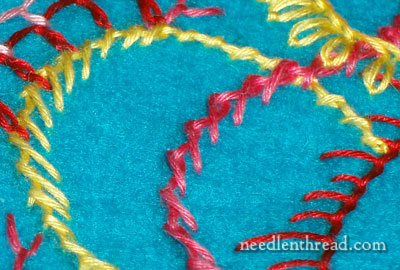The twisted chain stitch is a decorative line stitch that’s great for curves, straight lines, seam treatments in crazy quilting, or stems and branches in all kinds of surface embroidery (think: crewel work). Depending on how far you enter the fabric from the line you’re following, the “barb” on the twisted chain stitch will either be very noticeable (if you take your needle into the fabric far above or below your line) or hardly noticeable at all (if you work close to your line).

In the photo above, the pink and yellow lines are both worked with twisted chain stitch. On the yellow line, you can see how the line looks completely different, because I changed the length of the “barbs” on the stitch. You’ll see what I mean by “barbs” once you watch the video!
When the twist is kept close the line of stitches (so that there isn’t much of a barb at all), the twisted chain stitch worked along a line looks a lot like a line of little fish swimming along, nose-to-tail!
The twisted chain stitch forms the base of other embroidery stitches, so it’s a good stitch to have in your repertoire. For example, oyster stitch and rosette chain both begin like the twisted chain stitch, and berwick stitch is a combination of twisted chain and buttonhole stitch.
I hope you enjoy the video!
You can find heaps more How to Embroider Videos here on the Needle ‘n Thread – and if you’re looking for a particular stitch and can’t find it, let me know, and I’ll see if I can work something up for you!
Have a terrific weekend!
Looking for inspiration & information on hand embroidery?
There are all kinds of reasons to sign up for the Needle ‘n Thread daily newsletter! Check them out and sign up today!
If you like what you see on Needle ’n Thread, if you want to be a part of keeping the website thriving (and free of annoying network advertising), why not become a patron on Patreon? Check out my Patreon page here, where I’ll occasionally add special needlework bonuses for patrons.
If you shop on Amazon, you can support Needle ’n Thread without any extra expense to you by visiting my Amazon Recommendations page here, where you’ll find books and sundries for the needleworker available on Amazon.







Twisted chain – one of my favorite stitches. I appreciate that you also demonstrated the barred variations. Thank you.
That’s a neat stitch. I have some patterns for Christmas ornaments that I will try that out on. Thanks for the demo.
Glad you like it! Hey – another idea – in the round, with larger “barbs” – the base of a wreath. Then go back with individual daisy stitches and French knots and “fill in.”
thanks a lot for your videos. I try to link each of them in my second blog
http://annuairebroderie.canalblog.com/
They are very helpful, even for people who do not speak english.
Have a nice week 😉
Cheers
Elena
Hi Mary a big thank you for your video’s, it makes it so easy for us people trying to teach ourself’s how to embroider.
Lyn M
Australia
Hello Mary, I’m only 13 and I’ve just started to learn hand-embroidery, I just wanted to ask, what are the kinds of thread you mostly use in hand-embroidery?
Hi, Lois – There are all kinds of threads you can use for hand embroidery. The most common is DMC stranded cotton, which comes in lots of colors and shades, and is relatively inexpensive. In the videos, I usually use perle cotton, so it can be easily seen, but I don’t normally do a lot of hand embroidery with perle cotton. It’s fun for samplers, though. Another cotton thread I like a lot is floche, but it isn’t as easy to come by as stranded cotton floss. You have to order floche online. My favorite thread to work with is silk, but it’s a lot more expensive, and usually has to be ordered online, too, unless you have a locally owned needlework shop close by. Hope that helps! ~MC
It is very helpful but for left handed person like me I find it difficult to adapt it thanks any way
I cannot find any examples of the twisted chain stitch does in the “stab” method. Can it be done this way or is it only done in the “sew” method.
P.S. Yes, I’m very new to embroidery.
I always use the stab method when I stitch.
When the needle comes up into the fabric for the stitch, take the loop of thread that’s on the top of the fabric between the two “leg” points, and twist the stitch and drop it over the needle.
This video has help me do my chain stitches to perfection. Thanks so much
Thanks this was a perfect video showing how to do the twisted stitch. I’m very excited to use it on a project!